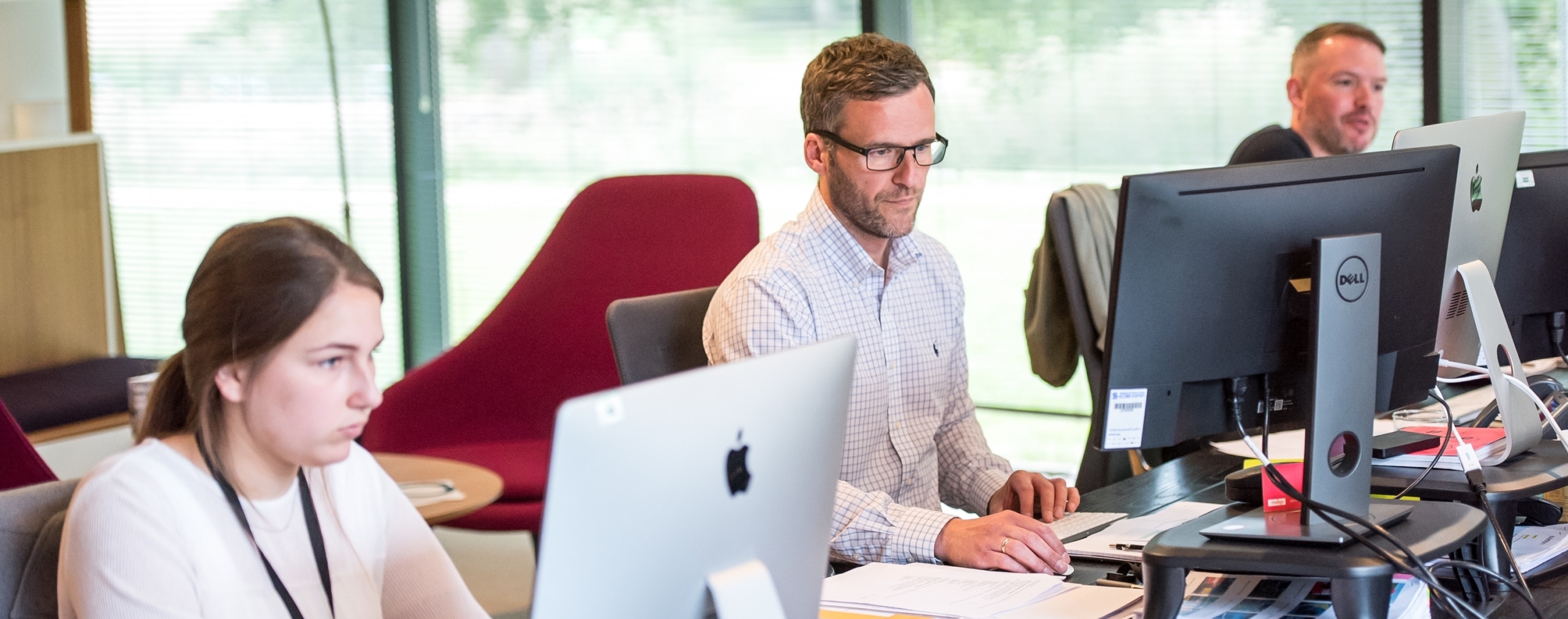
Table of Contents
Welcome to the comprehensive guide on the key skills of an effective corporate trainer. In the dynamic world of corporate training, success hinges upon a unique blend of expertise, charisma, and emotional intelligence. In this course, we will explore the essential skills that empower corporate trainers to inspire, engage, and ignite transformative growth within organizations. Prepare to embark on a journey infused with passion, enthusiasm, and a deep understanding of human connection in the corporate landscape.

As we venture into the realm of corporate training, let us embrace the power of empathy. Exceptional corporate trainers forge connections with individuals on a personal level, understanding their unique perspectives and challenges. By fostering empathy, trainers create an inclusive and supportive learning environment where participants feel valued, motivated, and inspired. Passion is the driving force that fuels corporate training excellence. Effective trainers infuse their sessions with infectious enthusiasm, igniting a spark of curiosity and hunger for knowledge within participants. By sharing real-life examples, success stories, and showcasing genuine excitement, trainers kindle the flame of inspiration and empower participants to embrace new concepts with vigor. Communication lies at the heart of impactful corporate training. A skilled trainer possesses not only exceptional speaking abilities but also active listening skills. By truly understanding and responding empathetically, trainers ensure that their messages resonate with participants, fostering engagement and a sense of collaboration. Clear, concise, and persuasive communication elevates corporate training to new heights. Adaptability is a vital skill for trainers navigating the ever-evolving corporate landscape. The ability to tailor training methods, content, and delivery to meet the unique needs of diverse audiences enhances the trainer’s impact. Embracing versatility allows trainers to effectively address the challenges and dynamics of different corporate environments, creating engaging and relevant training experiences. Incorporating interactivity is a hallmark of effective corporate trainers. By utilizing group discussions, case studies, role-plays, and simulations, trainers promote active participation and peer learning. Nurturing a culture of collaboration cultivates the seeds of team synergy, fostering collective problem-solving prowess and facilitating the seamless integration of knowledge into real-world workplace scenarios. Organizational skills are vital for corporate trainers to design and deliver impactful training programs. Well-structured and meticulously planned sessions provide a clear roadmap for participants, ensuring a seamless flow of information. Through effective organization, trainers instill confidence and credibility, enabling participants to absorb and retain knowledge more effectively. Confidence is a key attribute of successful corporate trainers. By exuding confidence in their expertise and delivery, trainers inspire trust and credibility among participants. Within such an environment, an inviting atmosphere takes shape, coaxing participants to bravely embrace challenges, wield the power of critical thinking, and wholeheartedly immerse themselves in the vibrant tapestry of the learning journey.
Flexibility is a critical skill for corporate trainers to adapt to unexpected situations and tailor training to meet specific needs. A trainer’s ability to pivot and adjust their approach ensures a personalized and effective learning experience for participants. Flexibility allows trainers to respond to feedback, address concerns, and create a dynamic training environment. Storytelling is an artful tool used by effective corporate trainers to captivate participants’ attention and make learning memorable. Through engaging narratives, trainers connect emotionally with participants, illustrating the practical application of concepts in real-life scenarios. Storytelling enhances understanding, retention, and participant engagement within the corporate training context. In the realm of corporate training, authenticity reigns supreme. Effective trainers embrace their own unique identity, allowing their genuine selves to shine through. By staying true to their values and beliefs, trainers create an authentic connection with participants, fostering trust, openness, and a sense of shared purpose. Authenticity breeds a supportive and inclusive learning environment, where individuals feel empowered to bring their whole selves to the table. Motivation is the driving force behind transformative learning experiences. Effective trainers inspire and motivate participants to strive for excellence by setting clear goals, providing constructive feedback, and recognizing achievements. By fostering a culture of motivation, trainers empower participants to unleash their full potential and drive organizational growth. The ability to navigate cultural diversity is a hallmark of exceptional corporate trainers. In today’s globalized workplace, trainers must understand and appreciate the richness of different cultures, beliefs, and perspectives. By promoting inclusivity, trainers cultivate an environment that celebrates diversity, fostering respect, collaboration, and cross-cultural understanding among participants. This enriches the learning experience and encourages a global mindset within the corporate setting.
A growth mindset is a powerful asset for corporate trainers seeking to inspire continuous improvement within organizations. By fostering a culture of curiosity, resilience, and a willingness to embrace challenges, trainers cultivate a growth mindset among participants. Encouraging a belief in the capacity for growth and the value of learning from mistakes, trainers empower individuals to unlock their full potential, drive innovation, and push the boundaries of what is possible within the corporate realm. Self-reflection is a vital practice for corporate trainers to refine their skills and enhance professional growth. By regularly evaluating their performance, seeking feedback, and continuously learning, trainers stay at the forefront of industry trends and advancements. Embracing self-improvement ensures that trainers consistently deliver high-quality training experiences. In the fast-paced world of business, effective corporate trainers possess resilience and the ability to thrive in challenging circumstances. They embrace change as an opportunity for growth, adapt their strategies to evolving needs, and navigate ambiguity with confidence. Resilient trainers inspire resilience within participants, equipping them with the skills and mindset to embrace change, overcome obstacles, and navigate the complexities of the modern corporate landscape. As you reach the culmination of this transformative voyage, remember that the role of a corporate trainer extends beyond imparting knowledge. It is about creating an environment that nurtures the holistic development of individuals. By encouraging personal growth, fostering leadership skills, and cultivating a passion for lifelong learning, trainers empower participants to become catalysts of change within their organizations. Embrace your role as a catalyst and be the guiding light that ignites the spark of excellence in others.
Congratulations! You have completed the immersive journey through the key skills of an effective corporate trainer. Equipped with the formidable arsenal of empathy, unwavering passion, masterful communication, remarkable adaptability, and captivating interactivity, you stand ready to leave an indelible imprint upon the corporate landscape, propelling lasting transformation and driving profound impact. Remember, by harnessing these skills, you have the power to inspire, engage, and empower participants, transforming organizations and driving collective success. Go forth and make a difference as an exceptional corporate trainer!
As corporate trainers, we possess the incredible power to shape minds, ignite passions, and inspire growth. To truly engage learners and create a lasting impact, we must master the art of effective training techniques. Our mission is to transform dull sessions into dynamic experiences, where curiosity is kindled, and knowledge is embraced with enthusiasm. Picture this: a training room buzzing with energy, as learners eagerly participate in interactive activities. One of the key techniques for captivating your audience is the use of multimedia. Harness the power of visually stunning presentations, engaging videos, and thought-provoking images. Let your materials speak to the hearts and minds of your learners, leaving a lasting impression that resonates beyond the training session. But remember, dear trainers, effective training techniques extend beyond the realm of technology. Inject the human touch by incorporating storytelling into your sessions. Share compelling anecdotes that ignite emotions, allowing your learners to connect with the subject matter on a personal level. Embrace the power of narrative to paint vivid pictures in their minds, making the learning experience more relatable and memorable. To truly engage learners, foster an environment of active participation. Break away from traditional lecture-style sessions and encourage dialogue and collaboration. Engage in lively discussions, encourage questions, and value the diverse perspectives of your learners. By creating a safe space for expression, you empower individuals to learn from each other and discover new insights collectively.

Variety is the spice of effective training! Keep your learners on their toes by incorporating a range of interactive activities. From role-playing scenarios to group exercises, from hands-on simulations to gamified challenges, provide a dynamic learning experience that keeps boredom at bay. By embracing diverse training methodologies, you cater to different learning styles and ensure maximum engagement. Passion is contagious. Infuse your training sessions with a genuine enthusiasm for the subject matter. Let your love and knowledge of the topic shine through your delivery. Be a beacon of inspiration, igniting curiosity and motivating learners to explore further. When they witness your own excitement, they will be more inclined to embrace the learning journey with equal fervor. Remember, dear trainers, that assessment is not the end but a means to measure progress and reinforce learning. Incorporate interactive quizzes, practical assignments, and group projects to assess comprehension and application. By offering timely feedback and recognizing achievements, you inspire a sense of accomplishment and encourage continuous growth. In conclusion, dear trainers, by employing these effective training techniques, you possess the power to transform training sessions into transformative experiences. Embrace the use of multimedia, storytelling, active participation, and a variety of interactive activities. Infuse your sessions with passion and provide meaningful assessments. Together, let us create a learning environment that sparks curiosity, inspires growth, and leaves a lasting impact on every learner’s journey.
As corporate trainers, we must recognize the importance of creating a supportive and inclusive learning environment. Show empathy towards your learners and foster a sense of belonging. Acknowledge their diverse backgrounds, experiences, and learning styles. By tailoring your training approach to meet individual needs and encouraging mutual respect, you create a space where everyone feels valued and motivated to actively participate. One of the most powerful training techniques is the art of storytelling. Harness the emotive power of narratives to captivate your learners’ hearts and minds. Share personal anecdotes, success stories, or even challenges you have faced. Connect on a deeper level by evoking emotions such as empathy, inspiration, or even a touch of humor. Through storytelling, you can transport learners into a world where learning becomes an immersive and transformative experience. Effective training techniques involve the skillful use of visuals and graphics. Incorporate appealing visuals, infographics, and charts that enhance the learning experience. Visual stimuli can engage learners on multiple levels, aiding comprehension and memory retention. Remember, a well-designed visual not only conveys information but also evokes emotions that reinforce the learning process. To truly engage learners, we must cultivate a growth mindset. Encourage individuals to embrace challenges, view failures as opportunities for learning, and celebrate successes. Nurture a culture of continuous improvement and curiosity. By fostering a growth mindset, learners develop the resilience and motivation to go beyond their comfort zones, unlocking their true potential.
The power of feedback cannot be underestimated in effective training techniques. Provide constructive feedback that is specific, actionable, and encouraging. Recognize the effort and progress made by learners, reinforcing their confidence and motivation. Aim to create a feedback loop that encourages continuous learning and development, fostering a sense of achievement and personal growth. As corporate trainers, we must adapt to the ever-evolving digital landscape. Explore innovative technologies such as virtual reality, augmented reality, or online platforms to enhance the training experience. Embrace the possibilities of gamification, where learners can engage in challenges, earn points, and unlock achievements. By leveraging technology, we can create immersive and interactive training experiences that resonate with learners in the digital age. In conclusion, effective training techniques require a blend of passion, empathy, and creativity. Create an inclusive environment, harness the power of storytelling and visuals, and encourage a growth mindset. Provide constructive feedback and embrace technological advancements to enhance the learning journey. With these tips, corporate trainers can embark on a transformative mission, empowering learners to thrive in a rapidly changing world.
Emotional intelligence plays a pivotal role in building meaningful connections between trainers and participants, fostering an environment that enhances learning and drives organizational success. Trainers with high emotional intelligence bring a heightened self-awareness to their training sessions, creating an emotional landscape that resonates with authenticity and empathy. Participants are drawn to trainers who genuinely connect with their emotions, fostering a sense of trust and openness. Emotional intelligence empowers trainers to effectively navigate the emotional terrain of their participants. By recognizing and validating participants’ emotions, trainers create a safe space for open dialogue and exploration. This emotional connection sparks engagement, as participants feel seen, heard, and understood. Trainers with emotional intelligence possess a deep understanding of the impact emotions have on the learning experience. They recognize that emotions can either facilitate or hinder learning and adjust their approach accordingly. By creating an emotionally positive and supportive training environment, trainers evoke emotions of motivation, curiosity, and enthusiasm among participants, enhancing their receptiveness to new knowledge and skills. Emotional intelligence also plays a crucial role in fostering effective communication during corporate training. Trainers who possess emotional intelligence can accurately perceive the emotions of their participants, adapting their communication style and content delivery to suit individual needs. They use empathetic listening and non-verbal cues to create a deeper connection, evoking emotions of trust, respect, and understanding.

Trainers with high emotional intelligence can read the emotional cues of their participants, discerning their needs, concerns, and motivations. This emotional attunement allows trainers to tailor their training approach, providing support and guidance that address participants’ specific emotional states. Emotional intelligence promotes self-regulation among trainers, enabling them to manage their own emotions during training sessions. Trainers who can effectively manage their emotions remain calm, composed, and adaptable in the face of unexpected challenges or disruptions. This emotional resilience creates an atmosphere of stability and inspires confidence among participants. Furthermore, emotional intelligence cultivates social awareness in trainers, allowing them to navigate the dynamics of group interactions. They possess a keen understanding of group dynamics, emotions, and conflicts, enabling them to address and resolve issues that may arise during training sessions. This emotional agility promotes collaboration, cooperation, and a sense of shared purpose among participants. Trainers with emotional intelligence have a heightened ability to provide constructive feedback. They approach feedback with sensitivity, recognizing the emotional impact it can have on participants. By delivering feedback in a supportive and empathetic manner, trainers inspire growth, evoking emotions of motivation and self-improvement. Emotional intelligence also fosters a culture of empathy within corporate training. Trainers who model empathy inspire participants to develop their own emotional intelligence and empathy, creating an environment that values diverse perspectives and encourages understanding. This emotional connection deepens the learning experience, as participants feel valued, supported, and inspired to explore new ideas and approaches.
Emotional intelligence in corporate training goes beyond the classroom. Trainers with emotional intelligence understand the larger organizational context and dynamics. They are aware of the pressures, challenges, and expectations that participants face in their work environments. This knowledge enables trainers to tailor the training content and exercises to address real-world scenarios, evoking emotions of relevance and practicality among participants. Emotional intelligence fosters resilience and adaptability in trainers. They can adapt their training methods and content delivery to meet the changing needs of participants and organizations. This emotional agility ensures that the training remains effective and impactful, even in the face of evolving circumstances. Trainers who demonstrate resilience inspire participants to embrace change, evoking emotions of empowerment and growth. Emotional intelligence also plays a significant role in conflict resolution during corporate training. Trainers with emotional intelligence can effectively navigate conflicts, ensuring that they are addressed in a constructive and empathetic manner. By fostering open dialogue and understanding, trainers evoke emotions of resolution and collaboration, creating a harmonious training environment. Trainers with emotional intelligence are skilled at building rapport and trust with participants. They create a supportive and non-judgmental atmosphere where participants feel comfortable expressing themselves openly. This emotional connection fosters a sense of psychological safety, enabling participants to take risks, share ideas, and engage fully in the learning process.
Emotional intelligence enhances trainers’ ability to manage group dynamics during training sessions. They are attuned to the emotions and interactions within the group, allowing them to address any tensions or conflicts that may arise. This emotional awareness fosters a sense of camaraderie and cohesion, evoking emotions of unity and shared purpose. Trainers with emotional intelligence are adept at managing the energy and engagement levels of participants. They can gauge the emotional states of participants and adjust the training pace or activities accordingly. This emotional sensitivity ensures that participants remain motivated, energized, and focused throughout the training. Emotional intelligence promotes self-reflection and continuous personal growth among trainers. They regularly assess their own emotional responses, seeking opportunities for improvement and refinement. This commitment to self-development inspires participants to embrace a similar mindset, fostering a culture of continuous learning and growth. Trainers with emotional intelligence are skilled at recognizing and celebrating the achievements and progress of participants. They provide genuine and specific praise, evoking emotions of pride and accomplishment. This emotional reinforcement motivates participants to continue their learning journey and inspires a sense of self-belief. Emotional intelligence enables trainers to create a positive and uplifting training atmosphere. They infuse the training sessions with enthusiasm, optimism, and a genuine passion for the subject matter. This emotional energy is contagious, evoking emotions of excitement and inspiration among participants.
In conclusion, emotional intelligence plays a vital role in corporate training by building connections and enhancing learning. Trainers with emotional intelligence create an environment where participants feel understood, supported, and empowered. Through self-awareness, empathy, effective communication, and adaptability, trainers foster an atmosphere that inspires collaboration, growth, and personal transformation. Let us embrace the power of emotional intelligence in corporate training, for it has the capacity to nurture meaningful connections, drive organizational success, and unleash the full potential of individuals and teams.
Welcome, my passionate corporate trainers, to this inspiring course on mastering presentation skills. As trainers, your ability to deliver impactful and compelling presentations is vital in driving learning and development within the corporate world. Let us explore essential techniques that will elevate your presentation skills to new heights. Confidence, my confident trainers, is the cornerstone of mastering presentation skills. Believe in yourself and your expertise, exuding confidence that captivates your audience. Confidence breeds trust and enables you to deliver your message with conviction and authority. Preparation, my diligent trainers, is the key to delivering successful presentations. Dedicate ample time to research, organize, and structure your content. Prepare engaging visual aids, handouts, and interactive activities that enhance the learning experience. Thorough preparation instills confidence and sets the stage for a seamless presentation. Engaging storytelling, my storytellers at heart, captivates your audience and brings your content to life. Incorporate personal anecdotes, relevant case studies, or powerful narratives that resonate with your audience. Stories create emotional connections and make information memorable.

Visual aids, my visual communicators, complement your message and enhance audience understanding. Utilize clear and visually appealing slides, infographics, or videos to support your presentation. Visual aids should be concise, relevant, and visually stimulating, reinforcing key points and capturing attention. Active audience engagement, my interactive trainers, creates a participatory learning experience. Encourage questions, facilitate discussions, and incorporate interactive exercises. Engage participants in hands-on activities, role-plays, or group exercises that foster collaboration and reinforce learning. Non-verbal communication, my expressive presenters, speaks volumes during presentations. Pay attention to your body language, facial expressions, and gestures. Maintain eye contact, use open and confident posture, and vary your vocal tone to convey your message effectively. Adaptability, my flexible trainers, is crucial for addressing diverse audience needs. Be prepared to adapt your presentation based on audience reactions and feedback. Adjust your pace, content emphasis, or delivery style to ensure that your message resonates with different learning styles and preferences. Clarity and simplicity, my clear communicators, enhance audience comprehension. Structure your presentation logically, using concise and straightforward language. Break down complex concepts into easily digestible chunks, reinforcing understanding and facilitating retention. Visualizing success, my visionary trainers, fuels your confidence and enhances your presentation skills. Visualize yourself delivering a dynamic and impactful presentation. Envision engaged and receptive participants, an atmosphere of learning, and a positive impact on your audience. Visualization fosters a positive mindset and sets the stage for success. Continual improvement, my lifelong learners, is essential for mastering presentation skills. Seek feedback from colleagues, participants, or mentors to refine your techniques. Attend workshops, explore new presentation tools and methodologies, and stay updated with industry trends. Embrace a growth mindset, continuously evolving and improving your skills. Passion, my passionate trainers, is the secret ingredient that elevates your presentation skills. Infuse your delivery with enthusiasm and genuine passion for your subject matter. Passion is contagious and inspires participants to engage, learn, and be inspired by your message.
Empathy, my empathetic trainers, is a powerful technique in connecting with your audience. Put yourself in their shoes, understand their challenges, and address their needs. Empathy creates a supportive and inclusive learning environment, fostering trust and engagement. Adapting to technology, my tech-savvy trainers, is essential in today’s digital age. Embrace presentation tools, virtual platforms, and interactive features to deliver engaging and dynamic presentations. Utilize multimedia elements, online collaboration tools, and interactive polls to create an immersive learning experience. Structured storytelling, my compelling storytellers, adds impact to your presentations. Craft narratives with a clear beginning, middle, and end. Use storytelling techniques, such as suspense, conflict, and resolution, to engage your audience emotionally and drive your message home. Empowerment through exercises, my empowering trainers, enables participants to apply their learning. Incorporate practical exercises, simulations, or role-plays that allow participants to practice new skills in a safe and supportive environment. Empower participants to take ownership of their learning journey. Adopting a growth mindset, my growth-oriented trainers, encourages continuous learning and improvement. Embrace challenges, seek feedback, and view setbacks as opportunities for growth. A growth mindset fosters resilience, creativity, and a commitment to delivering exceptional presentations. Authentic connection, my authentic presenters, builds rapport and trust with your audience. Share personal experiences, show vulnerability, and create a safe space for open dialogue. Authenticity cultivates a genuine connection that engages and inspires participants. Visualizing your audience’s success, my visionary trainers, creates a sense of purpose in your presentation. Visualize your audience applying their newfound knowledge, skills, or insights to achieve their goals. Seeing the positive impact you can have on their professional development fuels your passion and drives your delivery. Dynamic delivery, my dynamic presenters, keeps your audience engaged throughout your presentation. Utilize voice modulation, pacing, and emphasis to maintain energy and captivate attention. Use body language, props, or visual cues to add excitement and create a memorable experience.
Creating memorable moments, my memorable trainers, involves incorporating surprise elements or interactive elements. Surprise participants with captivating anecdotes, relevant videos, or thought-provoking questions. These memorable moments create a lasting impact and enhance participant engagement. Mentorship and collaboration, my collaborative trainers, foster a culture of continuous learning. Seek opportunities to learn from experienced trainers, exchange ideas, and collaborate on joint presentations. Engaging in mentorship and collaboration expands your knowledge, skills, and perspectives. Effective use of humor, my humorous trainers, adds levity and relatability to your presentations. Incorporate appropriate humor to ease tension, connect with your audience, and create an enjoyable learning experience. Humor breaks down barriers and creates a positive and engaging atmosphere. Evaluation and reflection, my reflective trainers, are essential for continuous improvement. Evaluate the effectiveness of your presentations, gather feedback from participants, and reflect on areas for growth. Embrace a culture of self-reflection, learning from each presentation and refining your techniques accordingly.
Corporate training programs play a pivotal role in enhancing employee skills, driving organizational growth, and fostering a positive work culture. To design effective training programs, trainers must employ best practices and strategies that evoke emotions of enthusiasm, engagement, and empowerment. Here, we explore key principles for designing impactful corporate training programs that deliver tangible results. Identify Learning Objectives: Clearly define the learning objectives and desired outcomes of the training program. Understanding what participants should be able to do or achieve by the end of the training helps trainers design targeted and relevant content. Conduct Needs Assessments: Conduct thorough needs assessments to identify the specific knowledge gaps and skill development needs within the organization. This ensures that training programs address the most pressing issues and align with participants’ needs and aspirations.

Use Interactive and Engaging Methods: Incorporate a variety of interactive training methods to promote active learning. Utilize techniques such as case studies, role-playing, group discussions, and hands-on activities. These methods evoke emotions of curiosity, excitement, and collaboration, leading to enhanced engagement and retention of information. Customization and Personalization: Tailor training programs to the unique context of the organization and the participants’ roles. By incorporating real-life examples and scenarios relevant to participants’ work, trainers create a sense of relevance and applicability, fostering a deeper emotional connection to the training content.
Embrace Technology: Leverage technology to enhance the training experience. Utilize learning management systems, online modules, and virtual collaboration tools to deliver training content effectively and provide opportunities for remote learning. Technology-driven approaches evoke emotions of convenience, modernity, and empowerment. Reinforce Learning with Assessments: Incorporate formative and summative assessments to reinforce learning and evaluate participants’ progress. Assessments evoke emotions of challenge and achievement, encouraging participants to actively engage with the training material and measure their own growth.
Continuous Learning Opportunities: Design training programs as part of a broader learning journey, providing continuous learning opportunities beyond the initial program. Encourage participants to seek further development through additional resources, coaching, or follow-up sessions. This promotes a culture of lifelong learning and evokes emotions of growth and self-motivation. Evaluate and Measure Impact: Implement an evaluation process to measure the effectiveness and impact of the training program. Collect feedback from participants and stakeholders to gauge satisfaction, knowledge transfer, and the practical application of acquired skills. This data-driven approach allows trainers to refine and improve future training initiatives, evoking emotions of accountability and commitment to continuous improvement.
In conclusion, designing effective corporate training programs requires a thoughtful and strategic approach. By identifying clear learning objectives, customizing content, using interactive methods, embracing technology, and providing continuous learning opportunities, trainers can create impactful programs that evoke emotions of enthusiasm, engagement, and empowerment. Incorporating assessments and evaluation processes ensures ongoing improvement, making the training programs more effective and valuable for participants and the organization as a whole.
Facilitation is an art that holds the power to transform corporate training experiences. As corporate trainers, we have the privilege of shaping minds, inspiring growth, and driving change within organizations. This essay explores the core skills that lie at the heart of effective facilitation, enabling us to create engaging and impactful learning environments that resonate with participants on an emotional level. Active listening is a foundational skill for corporate trainers. By attentively listening to participants’ needs, concerns, and aspirations, we demonstrate empathy and create a safe space for open dialogue. Active listening allows us to tailor our training content to meet the specific needs of individuals and address their challenges effectively. Creating a positive and inclusive learning environment is essential in corporate training. By fostering a culture of respect, trust, and collaboration, we encourage participants to share their ideas and perspectives openly. An inclusive environment promotes diverse thinking, enriches discussions, and fosters a sense of belonging among participants. Flexibility is a key attribute of effective facilitation. We adapt our training methods and approaches to suit the unique learning styles and preferences of participants. By recognizing and accommodating individual differences, we create an environment where all individuals can engage and thrive.

Effective communication lies at the heart of successful facilitation. We must convey complex concepts and ideas clearly, using language that is accessible and relatable to participants. Through clear communication, we enhance understanding, engage participants, and facilitate meaningful learning experiences. Facilitators must possess strong interpersonal skills. Building rapport, demonstrating empathy, and connecting with participants on an emotional level foster trust and create an environment where individuals feel safe to express themselves. Interpersonal skills enable facilitators to navigate diverse personalities and foster productive relationships. The ability to ask powerful and thought-provoking questions is a hallmark of skilled facilitators. By posing questions that encourage critical thinking, reflection, and discussion, we stimulate participants’ curiosity and inspire deeper exploration of the training content. Thoughtful questions ignite engagement and promote active learning. Effective time management is crucial for corporate trainers. We must ensure that training sessions are well-structured, allowing for the optimal use of time. By managing time effectively, we maintain participants’ engagement, deliver content efficiently, and maximize learning outcomes.
Adaptability is a valuable skill for corporate trainers. Unexpected challenges or disruptions may arise during training sessions, and the ability to adapt and think on our feet allows us to handle these situations with confidence and maintain a positive learning environment. Visual aids and multimedia resources enhance training experiences. Incorporating visuals, such as charts, graphs, or videos, captivates participants’ attention, reinforces key messages, and facilitates understanding. Well-designed visual aids support learning retention and make training sessions more engaging. Facilitators must possess strong problem-solving skills. The ability to analyze complex situations, identify solutions, and guide participants through challenging scenarios enables effective facilitation. Problem-solving skills empower facilitators to address issues that arise during training and create opportunities for growth and learning.
Empathy is a powerful attribute of skilled facilitators. By understanding and acknowledging participants’ emotions, needs, and perspectives, we create a supportive and inclusive learning environment. Empathy fosters trust, encourages active participation, and enhances the overall training experience. Creativity and innovation elevate facilitation to new heights. By incorporating interactive exercises, experiential learning, and novel approaches, we capture participants’ interest and make training sessions memorable. Creative facilitation sparks curiosity and inspires participants to explore new ideas and possibilities. Facilitators must be lifelong learners themselves. Staying updated with industry trends, exploring new methodologies, and continuously honing their skills ensures that facilitators provide relevant and impactful training experiences. By embracing a growth mindset, facilitators inspire participants to adopt a similar attitude towards their own development. The ability to provide constructive feedback is integral to effective facilitation. By offering feedback that is specific, actionable, and delivered with empathy, facilitators support participants’ growth and development. Constructive feedback promotes self-reflection, encourages continuous improvement, and enhances the transfer of learning to the workplace.
In conclusion, the art of facilitation encompasses a diverse range of core skills. Active listening, creating a positive learning environment, effective communication, interpersonal skills, powerful questioning, time management, adaptability, visual aids, problem-solving, empathy, creativity, lifelong learning, constructive feedback, and more. As corporate trainers, we strive to cultivate these skills, allowing us to craft engaging and impactful training experiences that resonate with participants on an emotional level. Let us embrace the art of facilitation, recognizing the profound impact we can have on individuals and organizations through our commitment to continuous learning, growth, and effective facilitation practices.
Building rapport with participants is a vital aspect of creating a positive learning environment in corporate training. It sets the foundation for engagement, collaboration, and effective knowledge transfer. As a trainer, there are several key strategies to build rapport and foster a positive learning atmosphere. Greeting participants with warmth and genuine interest sets the tone for the training session. Active listening plays a crucial role in building rapport. Paying attention to participants’ questions, comments, and concerns shows that their voices are valued and that their input is important. Engaging in meaningful dialogue and demonstrating empathy help establish trust and create an environment where participants feel comfortable expressing their thoughts and ideas.

Creating a safe space for open communication is also vital. Encouraging participants to share their experiences, opinions, and insights without fear of judgment or criticism promotes a supportive learning environment. Trainers can facilitate group discussions, encourage active participation, and foster a culture of respect and collaboration among participants. Tailoring the training experience to meet participants’ needs and goals is another effective strategy. Understanding the diverse backgrounds, skill levels, and learning preferences of participants allows trainers to customize the training content and methods accordingly. This personalized approach demonstrates a genuine commitment to the participants’ growth and development. Engaging participants through interactive activities and exercises is crucial for building rapport. Such activities foster a sense of camaraderie and create memorable learning experiences. Providing constructive feedback and recognition is a powerful way to build rapport. Acknowledging participants’ efforts, progress, and contributions during the training sessions boosts their confidence and motivation. Offering specific feedback that highlights strengths and areas for improvement demonstrates attentiveness and helps participants grow professionally. Being approachable and responsive is key to building rapport. Participants should feel comfortable approaching the trainer with questions, concerns, or additional support. Trainers should be accessible, respond promptly to inquiries, and demonstrate a genuine willingness to assist participants throughout the training journey. Lastly, creating a positive learning environment requires trainers to lead by example. Demonstrating enthusiasm, passion, and professionalism in delivering the training content helps to inspire participants. Trainers should display a positive attitude, exhibit strong communication skills, and foster a sense of enthusiasm for the subject matter, creating an environment where participants are motivated to actively engage and learn.
In conclusion, building rapport with participants is essential for creating a positive learning environment in corporate training. By establishing a welcoming atmosphere, actively listening, promoting open communication, tailoring the training experience, engaging participants, providing feedback and recognition, being approachable and responsive, and leading by example, trainers can cultivate a supportive and collaborative learning environment. This environment not only enhances knowledge retention and application but also fosters a sense of trust, respect, and enthusiasm among participants, leading to successful learning outcomes. To build rapport with participants, trainers should demonstrate a genuine interest in their individual needs and goals. Taking the time to understand their motivations and aspirations allows trainers to personalize the training experience and show participants that their development is valued. By addressing their specific challenges and aligning the training content with their professional objectives, trainers can foster a deeper connection and enhance engagement. Creating opportunities for collaboration and teamwork is another effective approach. By fostering a collaborative environment, trainers enable participants to build relationships, exchange knowledge, and support one another throughout the learning journey. Injecting appropriate humor and sharing relevant anecdotes can help create a relaxed and enjoyable atmosphere. It allows participants to feel more comfortable and connected with the trainer, promoting a positive and engaging learning environment. However, it’s important to strike a balance and ensure that humor and storytelling enhance the training without overshadowing the learning objectives. Building rapport is also about being sensitive to participants’ cultural backgrounds and individual differences. Trainers should foster an inclusive environment where everyone feels respected and valued. Being mindful of diverse perspectives, adapting teaching styles to accommodate different learning preferences, and promoting cultural awareness contribute to a positive and inclusive training atmosphere. Emphasizing the trainer’s expertise and credibility is essential in building rapport. Participants are more likely to engage and trust a trainer who demonstrates deep knowledge and experience in the subject matter. Sharing relevant insights, real-world examples, and practical tips can strengthen the trainer’s credibility and establish a sense of confidence and respect among participants. Lastly, continuous communication and feedback are crucial for maintaining rapport throughout the training program. By actively seeking feedback and demonstrating a willingness to adapt and improve, trainers show participants that their opinions and experiences matter, reinforcing the trust and rapport established from the beginning. In summary, building rapport with participants in corporate training involves demonstrating genuine interest, fostering collaboration, using humor and storytelling, being sensitive to individual differences, emphasizing expertise, and maintaining open communication. These strategies contribute to a positive learning environment where participants feel valued, engaged, and motivated to actively participate and apply their newfound knowledge and skills. By cultivating strong rapport, trainers can maximize the impact of their training programs and create meaningful connections that extend beyond the training room.
Welcome to a transformative exploration of leveraging technology in corporate training. In this exhilarating journey, we delve into the profound impact of technology on learning, empowering trainers with the skills and tools to create engaging and immersive training experiences. With heartfelt enthusiasm and a sense of wonder, we unlock the potential of technology as a catalyst for growth and innovation. As trainers, our hearts are ablaze with a passion for harnessing the power of technology to enhance corporate training. We embrace the emotional connection between learners and technology, understanding that the seamless integration of technology can spark curiosity, ignite motivation, and amplify the impact of our training efforts. With each technological advancement, our excitement grows, as we uncover new possibilities and horizons. Leveraging technology in corporate training begins with embracing a digital mindset. As trainers, we cultivate a deep emotional appreciation for the ever-evolving digital landscape. We view technology as a partner rather than a challenge, allowing it to ignite our creativity and expand our training horizons. By embracing this mindset, we foster an environment of continuous learning, adaptation, and innovation.

Technological literacy becomes our guiding light as trainers in the digital age. We approach technology with open hearts, immersing ourselves in its wonders and seeking to understand its vast potential. We dedicate ourselves to mastering the tools and platforms that facilitate immersive learning experiences. With each new skill acquired, our hearts swell with a sense of accomplishment, as we empower ourselves to create impactful training journeys. Technology opens a world of possibilities for customized learning experiences. As trainers, we recognize the emotional significance of tailoring training content to meet the unique needs and preferences of individual learners. Through adaptive learning platforms, personalized learning paths, and interactive multimedia tools, we create emotionally resonant and learner-centric experiences that propel growth and foster a sense of empowerment. Technology becomes a bridge that connects learners and trainers in a vibrant community of engagement and collaboration. With excitement and enthusiasm, we leverage collaborative tools, discussion forums, and virtual simulations to create an emotionally rich learning environment. By fostering interaction and shared experiences, we ignite the collective wisdom and creativity of learners, fueling deep engagement and fostering meaningful connections.
Gamification and immersive experiences capture the hearts and minds of learners, transforming training into an emotional and captivating adventure. As trainers, we explore gamified learning platforms, virtual reality simulations, and augmented reality applications, harnessing the power of storytelling, competition, and rewards to create memorable and impactful training experiences. With each immersive journey, we witness the magic of technology as it unlocks new levels of engagement and retention. Technology grants us access to a treasure trove of data, providing valuable insights into learner progress and training effectiveness. As trainers, our hearts race with anticipation as we dive into data analytics and learning management systems, uncovering patterns, trends, and areas for improvement. By harnessing this emotional connection to data, we make informed decisions, tailor our training strategies, and amplify the impact of our efforts. Technology becomes a catalyst for lifelong learning in the corporate training landscape. As trainers, we embrace a spirit of curiosity and adaptability, exploring emerging technologies and staying abreast of industry trends. We engage in online communities, attend webinars, and pursue professional development opportunities with emotional excitement, fueling our own growth and expanding our repertoire of technological skills.
Amidst the rapid advancement of technology, we hold space for emotional well-being in the digital realm. As trainers, we approach technology with mindfulness, balancing its benefits with the need for human connection and presence. We foster healthy digital habits, encourage mindful technology usage, and create opportunities for learners to disconnect and reflect. By nurturing digital well-being, we cultivate a harmonious integration of technology and emotional wellness. Technology becomes our guiding light in the era of remote and blended learning. As trainers, we embrace the emotional challenges and opportunities presented by virtual and hybrid training environments. We equip ourselves with skills and tools for seamless virtual facilitation, interactive online platforms, and collaborative digital workspaces. With each successful adaptation, our hearts soar, as we witness the resilience and growth of our learners in the face of change. Our passion for technology extends to fostering digital literacy among learners. As trainers, we ignite curiosity and excitement in our learners, empowering them to navigate the digital landscape with confidence and discernment. We provide guidance on responsible technology usage, online safety, and digital etiquette. By fostering digital literacy, we equip learners with the emotional intelligence to thrive in the digital age.
In the world of technology, innovation and experimentation fuel our hearts with excitement and wonder. As trainers, we cultivate a culture of innovation, encouraging ourselves and learners to explore new tools, platforms, and approaches. We celebrate failures as opportunities for growth and view setbacks as stepping stones on the path to success. By embracing this emotional connection to innovation, we push the boundaries of corporate training and create transformative experiences. Congratulations on your journey into leveraging technology in corporate training. As trainers, we navigate the ever-evolving digital landscape with passion, enthusiasm, and an emotional connection to the possibilities that technology brings. By developing technological literacy, customizing learning experiences, fostering engagement, and embracing innovation, we illuminate the future of corporate training, empowering learners to thrive in a digital world with confidence and purpose.
Assessing training needs in a corporate setting is a crucial process that helps organizations identify skills gaps and set clear objectives for their training programs. By understanding the specific needs and requirements of employees, trainers can design and deliver training initiatives that address these gaps and contribute to the overall success of the organization. One of the primary ways to assess training needs is through a thorough analysis of job roles and responsibilities. This involves closely examining the skills and competencies required for each position within the organization. By conducting job analyses, reviewing job descriptions, and engaging with managers and employees, trainers can gain a comprehensive understanding of the knowledge and skills necessary for effective job performance.

In addition to job analysis, feedback from employees and managers plays a vital role in assessing training needs. These interactions provide valuable information about existing skill levels, areas for improvement, and the specific training needs identified by employees themselves. Another valuable approach to assessing training needs is through performance evaluations and reviews. By analyzing performance data, trainers can identify any performance gaps or areas where employees may need additional support or training. This data-driven approach helps organizations pinpoint specific skill areas that require attention and allocate resources effectively. Moreover, staying informed about industry trends and advancements is essential for assessing training needs in a corporate setting. Trainers must continuously monitor changes in the industry, technological advancements, and evolving market demands. By keeping abreast of these developments, trainers can identify emerging skill requirements and ensure that training programs align with current industry standards.
Collaboration with key stakeholders, such as department heads and senior leaders, is another critical aspect of assessing training needs. By involving these stakeholders in the process, trainers can gain insights into the strategic goals and objectives of the organization. This collaboration helps trainers align training initiatives with the overall business strategy and ensures that training programs contribute to the organization’s long-term success. Furthermore, analyzing organizational performance metrics and data can provide valuable insights into training needs. By reviewing metrics such as employee turnover rates, customer satisfaction scores, or productivity levels, trainers can identify areas where training interventions may be required to improve overall organizational performance. Considering the impact of technological advancements and the changing nature of work is also crucial when assessing training needs. Rapid technological advancements may require employees to acquire new skills or adapt their existing skill set. Trainers need to identify these emerging needs and design training programs that equip employees with the necessary digital literacy and technical competencies.
In conclusion, assessing training needs in a corporate setting involves a multifaceted approach that incorporates job analysis, feedback from employees and managers, performance evaluations, industry awareness, collaboration with stakeholders, data analysis, and consideration of technological advancements. In addition to the methods mentioned above, conducting skill gap assessments can provide valuable insights into training needs. Skill gap assessments involve comparing the current skills and competencies of employees to the skills required for their roles. This can be done through various means such as skills tests, simulations, or self-assessment questionnaires. By identifying the gaps between the desired and existing skills, trainers can tailor training programs to bridge these gaps effectively. Furthermore, analyzing employee performance data and trends can help trainers identify common areas of improvement. By examining performance data across teams or departments, trainers can identify patterns and trends that indicate specific areas where training is needed. For example, if multiple teams struggle with customer service skills, targeted training programs can be developed to enhance those skills across the organization. Engaging in regular communication and feedback sessions with employees is essential for assessing training needs. By fostering an open and supportive environment, trainers can encourage employees to express their training needs and challenges. This feedback can provide valuable insights into specific areas where employees feel they require additional training or support. Observing employees in their work environment can also help trainers identify training needs. By directly observing employees’ performance, trainers can gain a firsthand understanding of their strengths, weaknesses, and areas for improvement. This observational approach can uncover training needs that may not be apparent through other assessment methods. Additionally, analyzing customer feedback and complaints can shed light on training needs. By reviewing customer feedback, trainers can identify recurring issues or areas where employees may require additional training to deliver exceptional customer service. This customer-centric approach ensures that training programs address the needs of both employees and customers. Trainers can also leverage benchmarking to assess training needs. Benchmarking involves comparing an organization’s performance and practices to industry standards or best practices. This helps identify areas where the organization may be falling behind or where improvements can be made through targeted training interventions. Lastly, considering future business goals and strategic initiatives is crucial when assessing training needs. Trainers should align their assessment with the organization’s long-term objectives to ensure that training programs support the organization’s growth and development. By anticipating future skill requirements and proactively identifying training needs, trainers can help the organization stay ahead of the curve. In summary, assessing training needs in a corporate setting requires a comprehensive approach that includes skill gap assessments, performance data analysis, employee feedback, direct observation, customer feedback analysis, benchmarking, and considering future business goals. By combining these methods, trainers can gain a holistic understanding of the organization’s training needs and develop targeted training programs that address skill gaps, improve performance, and contribute to the organization’s overall success.
Welcome to an emotional exploration of evaluating the impact of corporate training. In this transformative journey, we delve into the depths of measuring success and return on investment (ROI) with heartfelt passion and understanding. We recognize that evaluation goes beyond numbers and metrics; it encompasses the emotional impact of training, empowering trainers to make data-driven decisions that ignite growth and drive organizational success. Evaluation is the heartbeat that resonates through effective corporate training. As trainers, our hearts brim with excitement and curiosity as we embark on the journey of assessing the impact of our training programs. We understand that evaluation is not simply a process of measurement, but a means to uncover the emotional transformations, the growth, and the value created for individuals and organizations. To measure the impact of corporate training, we must first define what success and return on investment mean emotionally to us and our stakeholders. Success extends beyond the acquisition of knowledge; it encompasses the application of skills, the transformative growth in individuals, and the positive influence on organizational outcomes. ROI is not just financial; it reflects the emotional value generated by training, such as increased engagement, improved job satisfaction, and enhanced employee well-being.

A crucial step in evaluating the impact of corporate training is to establish clear objectives and emotional metrics from the outset. As trainers, our hearts are filled with purpose as we define specific, measurable, achievable, relevant, and time-bound (SMART) objectives. We identify emotional indicators that reflect the desired outcomes, such as increased confidence, improved teamwork, and enhanced customer satisfaction. These emotional metrics serve as guideposts on our journey of evaluation. Evaluating the impact of corporate training goes beyond quantifiable results; it requires emotional connections to learning outcomes. As trainers, we immerse ourselves in the emotional journeys of our learners, understanding their experiences, challenges, and growth. By listening, empathizing, and engaging in heartfelt conversations, we gain insight into the emotional transformations that occur. These emotional connections become the fabric of evaluation, illuminating the true impact of training. Emotional testimonials are powerful tools in evaluating the impact of corporate training. As trainers, we celebrate the moments when learners share their emotional stories of growth, empowerment, and transformation. These heartfelt narratives provide a deeper understanding of the emotional impact of training on individuals and the organization. By capturing and sharing these testimonials, we ignite inspiration and create a ripple effect of emotional engagement and commitment to training. The true measure of training impact lies in the application and behavior change beyond the training room. As trainers, we witness the emotional satisfaction that accompanies the transfer of knowledge into practice, the adoption of new skills, and the cultivation of desired behaviors. By observing and assessing these emotional changes, we gain insights into the effectiveness of training and its tangible impact on performance and organizational success.
Evaluating the impact of corporate training encompasses measuring organizational indicators. As trainers, our hearts soar with pride when we witness the emotional shifts in organizational culture, such as improved communication, increased collaboration, and enhanced innovation. By aligning training outcomes with organizational goals and measuring emotional changes at the team and organizational level, we gain a holistic understanding of the impact of training on the broader context. Emotional engagement and satisfaction are vital dimensions of evaluating the impact of corporate training. As trainers, we seek feedback and insights from learners, measuring their emotional connection to the training experience. We celebrate when learners express enthusiasm, gratitude, and a sense of fulfillment. By evaluating emotional engagement and satisfaction, we gauge the emotional resonance of training, which is a powerful indicator of its impact. Evaluating the impact of corporate training extends beyond immediate results; it embraces the long-term emotional impact on individuals and the organization. As trainers, our hearts are filled with joy when we witness sustained behavioral changes, continued growth, and ongoing application of skills. By fostering post-training support, providing reinforcement activities, and tracking long-term outcomes, we measure the emotional legacy of training in creating lasting transformation.
Return on investment in corporate training encompasses emotional value. As trainers, we delve into the emotional landscape of the organization, understanding the emotional shifts that occur as a result of training. We measure the emotional return on investment by assessing factors such as increased employee engagement, improved customer satisfaction, enhanced employee retention, and elevated organizational reputation. By calculating emotional ROI, we demonstrate the true value of training beyond financial metrics. Evaluation becomes a catalyst for continuous improvement in corporate training. As trainers, we approach evaluation with emotional resilience and a growth mindset. We view feedback, data, and insights as opportunities for reflection and refinement. By adapting our training approaches, content, and delivery based on emotional evaluation results, we ensure ongoing alignment with learners’ needs and organizational goals. Celebrating emotional milestones becomes an integral part of evaluating the impact of corporate training. As trainers, our hearts swell with pride when we witness the emotional transformations and successes of learners. We take moments to acknowledge and celebrate individual and organizational achievements, fostering a culture of emotional appreciation and motivation. By celebrating emotional milestones, we fuel a cycle of continuous growth and success. Congratulations on your journey of evaluating the impact of corporate training. As trainers, we recognize the emotional power of evaluation in driving growth, empowering individuals, and propelling organizational success. By defining success and ROI with emotional clarity, establishing clear objectives and metrics, capturing testimonials, assessing behavior change, and embracing continuous improvement, we unleash the transformative potential of evaluation and create a ripple effect of emotional growth and achievement.





